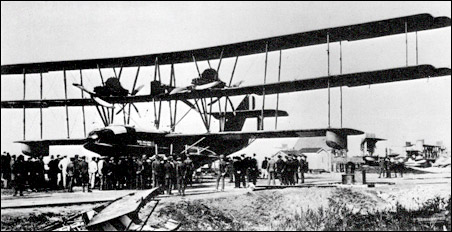|
| The Felixstowe Fury, also known as the Porte Super Baby, was a large British, five-engined triplane flying-boat designed by John Cyril Porte of the Seaplane Experimental Station, Felixstowe
Although the test-flying programme demonstrated the aircraft's suitability for long-distance flight, on 11 August 1919 (the eve of a planned flight from England to South Africa) it stalled into the sea on take-off, killing one member of the crew and suffering irreparable damage.
External links
| CREW | 7 |
| ENGINE | 5 x 334hp Rolls-Royce Eagle VIII inline piston engine |
| WEIGHTS |
| Take-off weight | 11483 kg | 25316 lb |
| Empty weight | 8438 kg | 18603 lb |
| DIMENSIONS |
| Wingspan | 37.5 m | 123 ft 0 in |
| Length | 19.26 m | 63 ft 2 in |
| Height | 8.38 m | 28 ft 6 in |
| Wing area | 288.8 m2 | 3108.61 sq ft |
| PERFORMANCE |
| Max. speed | 156 km/h | 97 mph |
| Ceiling | 3660 m | 12000 ft |
| David Pollard, 12.11.2015 00:54 Are you sure that it is the nose of the Felistowe Fury in the Flixton Museum because teh museum website states that it is a Felixstowe F5? reply |
| david Eadsforth, e-mail, 03.01.2014 18:47 I discovered the nose portion of the Fury, we had it moved to Flixton Museum where it has been restored. reply | | Terrence Murphy, e-mail, 15.11.2012 01:44 I found a picture on Flckr that shows a Fury with a different tail configuration. So there must have been some modifications made. reply | | Chris Bryant, e-mail, 25.06.2010 13:59 In keeping with its experimental role this aircraft was electric rudder controls at one time - the first use of fly-by-wire I think. It also had electric revolution counters for its engines. reply |
|
Do you have any comments?
|
| 
All the World's Rotorcraft |







Thats what we were told when we found it being used as a potting shed
by several; experts. But the Flixton museum are probably correct.
reply